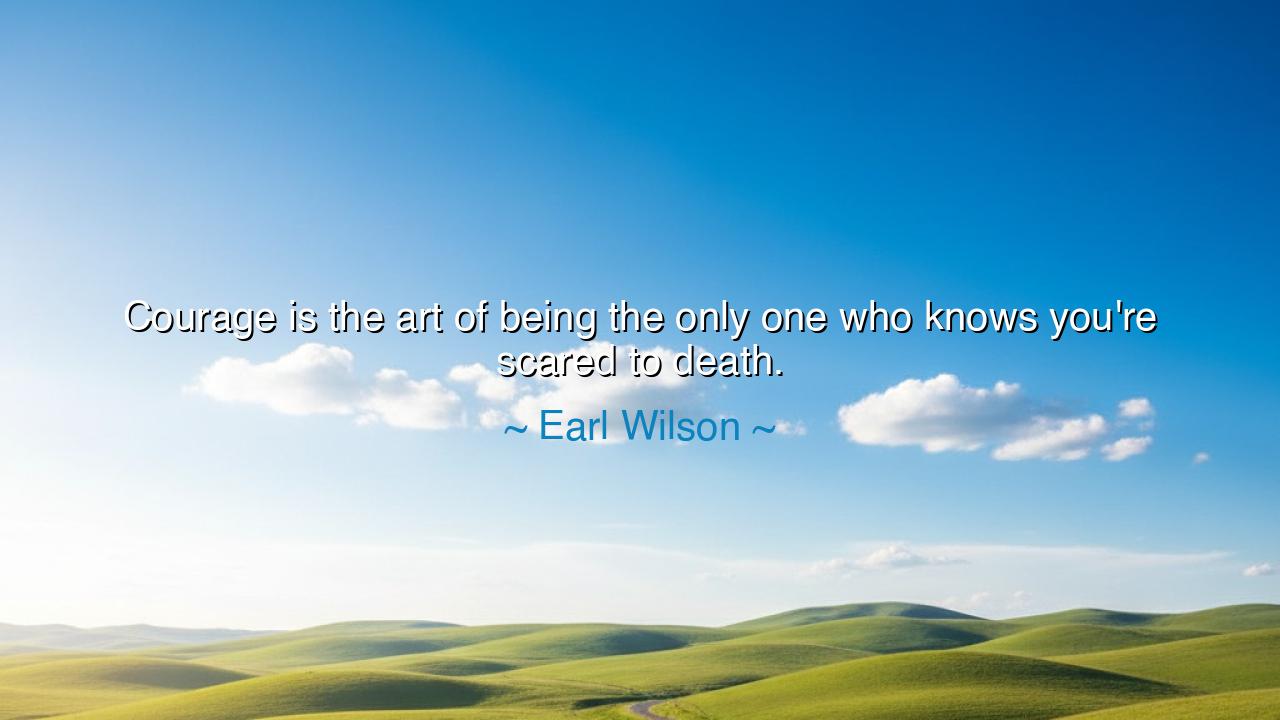
Courage is the art of being the only one who knows you're scared






"Courage is the art of being the only one who knows you’re scared to death." So said Earl Wilson, a journalist who understood that bravery is not the absence of fear but the mastery of it. His words pierce the heart like an arrow of truth, for they unveil the secret of every hero, every leader, every soul that has ever stood firm when trembling inside. To the world, courage shines as confidence, but within the soul of the courageous, there often beats a storm of doubt, fear, and uncertainty. True courage, then, is not born of ignorance, but of strength that conceals its trembling hand.
The ancients taught that valor is not the gift of the fearless, but the discipline of the fearful who act nonetheless. The Spartan stood shield to shield not because he did not fear death, but because he feared dishonor more. The samurai walked toward the enemy with steady steps not because his heart was cold, but because he had learned to rule it. In the same way, Earl Wilson’s words remind us that courage is not loud or boastful; it is quiet, inward, and resolute. It is the art—the discipline—of appearing steady while one’s heart quakes like the sea beneath a storm.
Consider the story of Joan of Arc, a young peasant girl who led armies, faced kings, and defied her captors. History remembers her for her unflinching resolve, her faith unbroken even upon the pyre. But imagine the fear that must have coursed through her veins—a girl surrounded by warriors, condemned by those in power, alone in the world save for her conviction. Surely she trembled, surely she wept. Yet she stood. That was her art—to let none see her fear, to let faith and purpose shine brighter than terror. That is courage: to feel fear’s full weight and still walk forward.
Fear, in truth, is not the enemy. It is the crucible in which courage is forged. Without fear, bravery has no meaning; without danger, valor has no light. The one who feels nothing does not act bravely—he acts blindly. But the one who feels everything and still advances—he becomes the measure of human strength. To be scared to death, as Wilson says, is no shame; the shame is only in surrender. The art lies in composure—in standing tall when your knees wish to buckle, in smiling when your heart pounds against your ribs like a trapped bird.
We see this same truth in every battlefield, every hospital ward, every home. The mother who shields her child in a moment of peril, the firefighter who runs into flame, the soldier who steps forward while others hesitate—all are afraid. But they know that some things are greater than fear: duty, love, honor, and the sacred call to protect life. Their faces may not reveal the storm within, yet it is there, and it is conquered only by courage. As the old warriors used to say, “The brave man is not he who feels no fear, but he who conquers it.”
Let us remember, too, that courage need not always roar. Sometimes it is the whisper that says, “I will try again tomorrow.” It lives in those who face illness, heartbreak, or despair and still rise to greet the day. To be the only one who knows you’re scared is to wear dignity as armor, to protect your own heart even as it quivers. This, too, is an art—one learned through life’s hardest lessons.
So take this teaching into your heart: do not wait for fear to vanish before you act. Do not believe that the brave feel no terror. When fear comes, let it come—but stand nonetheless. Speak when your voice shakes. Walk when your knees tremble. Smile when the storm rages within. For in that moment, unseen by others but known to your soul, you will become what you were meant to be: courage itself, shaped not by fear’s absence, but by your quiet triumph over it.
In the end, the world may never know how afraid you were. They will see only the strength you showed. And that is as it should be—for that is the true art of courage.






AAdministratorAdministrator
Welcome, honored guests. Please leave a comment, we will respond soon